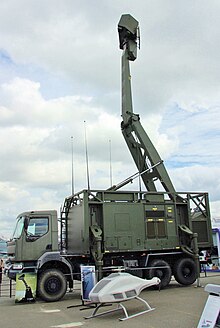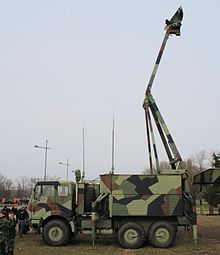This article has multiple issues. Please help improve it or discuss these issues on the talk page. (Learn how and when to remove these messages)
|
 A Giraffe AMB radar on display at the Paris Air Show, 2007. | |
| Country of origin | Sweden |
|---|---|
| Introduced | 1977 |
| No. built | 450~ |
| Type | Early warning radar |
| Frequency | C band/S Band/X band |
| RPM | 60 |
| Range | Between 10 and 470 kilometres (6.2 and 292.0 mi), depending on variant |
| Altitude | Between 0 and 40,000 metres (0 and 131,234 ft), depending on variant |
The Saab (formerly Ericsson Microwave Systems AB) Giraffe Radar is a family of land and naval two- or three-dimensional G/H-band (4 to 8 GHz) passive electronically scanned array radar-based surveillance and air defense command and control systems. It is tailored for operations with medium- and Short Range Air Defense (SHORAD) missile or gun systems, or for use as gap-fillers in a larger air defense system.
The radar gets its name from the distinctive folding mast which when deployed allows the radar to see over nearby terrain features such as trees, extending its effective range against low-level air targets. The first systems were produced in 1977. By 2007, some 450 units of all types are reported as having been delivered.
The Serbian Military Technical Institute purchased a licence for the Giraffe 75 and is producing a new model with several modifications. The radar is installed on the chassis of FAP 2026, and the Serbian designation is M85 "Žirafa".[1]

Saab Electronic Defence Systems (EDS) in May 2014 unveiled two new classes of active electronically scanned array (AESA) radar—three land-based systems (Giraffe 1X, Giraffe 4A and Giraffe 8A) and two naval variants (Sea Giraffe 1X and Sea Giraffe 4A) in X- and S-band frequencies—to complement its existing surface radar portfolio.[2]
- ^ "Војска Србије - Наоружање Копнене војске - Средства за противваздухопловна дејства - Противавионски топ 40 mm Л/70 БОФОРС". Archived from the original on 10 October 2016. Retrieved 25 December 2014.
- ^ "Saab expands surface radar portfolio". Archived from the original on 16 June 2014. Retrieved 9 June 2014.